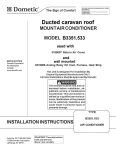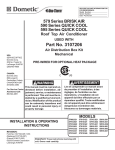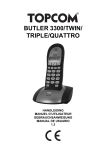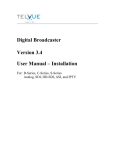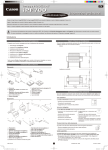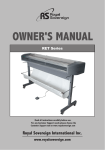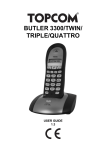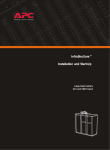Download Dometic B3351.531 Operating instructions
Transcript
INSTALLATION AND OPERATING INSTRUCTIONS RECORD THIS UNIT INFORMATION FOR FUTURE REFERENCE: Model Number Serial Number Date Purchased B3300 Series Roof Top Air Conditioner Used With Mechanical Air Distribution Box Kit 3309278.004 This manual must be read and understood before installation, adjustment, service, or maintenance is performed. This unit must be installed by a qualified service technician. Modification of this product can be extremely hazardous and could result in personal injury or property damage. INSTALLATION & OPERATING INSTRUCTIONS REVISION: Form No. 3308925.019 7/05 (Replaces 3308925.001) ©2005 Dometic Corporation LaGrange, IN 46761 Important: These instructions must stay with unit. Owner read carefully. 1 TYPE B3351.531 INSTALLATION AND OPERATING INSTRUCTIONS SAFETY INSTRUCTIONS This manual has safety information and instructions to help users eliminate or reduce the risk of accidents and injuries. RECOGNIZE SAFETY INFORMATION ! This is the safety-alert symbol. When you see this symbol in this manual, be alert to the potential for personal injury. Follow recommended precautions and safe operating instructions. UNDERSTAND SIGNAL WORDS A signal word , WARNING OR CAUTION is used with the safety-alert symbol. They give the level of risk for potential injury. ! WARNING indicates a potentially hazardous situation which, if not avoided, could result in death or serious injury. ! CAUTION indicates a potentially hazardous situation which, if not avoided may result in minor or moderate injury. CAUTION used without the safety alert symbol indicates, a potentially hazardous situation which, if not avoided may result in property damage. Read and follow all safety information and instructions. 2 INSTALLATION AND OPERATING INSTRUCTIONS SPECIFICATIONS TYPE NO. NOMINAL CAPACITY WATTS COOLING ELECTRICAL RATING COMPRESSOR RATED LOAD KW COMPRESSOR LOCKED ROTOR KW FAN MOTOR RATED LOAD KW FAN MOTOR LOCKED ROTOR KW REFRIGERANT R-22 GRAMS/OZ HEATER AMPS AT 220 / 240 VAC B3351.531 3,245 220 / 240 VAC, 50 HZ., 1PH. 1.1 / 1.2 4.5 / 5.0 0.21 0.46 510/18.0 1.64 giving it a "head start" on the expected high outdoor ambient will greatly improve its ability to maintain the desired indoor temperature. 7. For a more permanent solution to a high heat gain, accessories like outdoor patio and window awnings will reduce heat gain by removing the direct exposure to the sun. They also add a nice area to enjoy company during the cool of the evening. C. Condensation Note: The manufacturer of this air conditioner will not be responsible for damage caused by condensed moisture on ceilings or other surfaces. Air contains moisture and this moisture tends to condense on cold surfaces. When air enters the RV, condensed moisture may appear on the ceiling, windows, metal parts, etc. The air conditioner removes this moisture from the air during normal operation. Keeping doors and windows closed when this air conditioner is in operation will minimize condensed moisture on cold surfaces. GENERAL INFORMATION A. This air conditioner is designed for: 1. Installation on a recreational vehicle during or after the time the vehicle is manufactured. 2. Mounting on the roof of a recreational vehicle. 3. Roof construction with rafters/joists on minimum of 400mm centers. 4. Minimum of 25mm and maximum of 100mm distance between roof to ceiling of recreational vehicle. Alternate installation methods will allow for roofs more than 100mm thick. B. The ability of the air conditioner to maintain the desired inside temperature depends on the heat gain of the RV. Some preventative measures taken by the occupants of the RV can reduce the heat gain and improve the performance of the air conditioner. During extremely high outdoor temperatures, the heat gain of the vehicle may be reduced by: 1. Parking the RV in a shaded area 2. Using window shades (blinds and/or cur tains) 3. Keeping windows and doors shut or minimizing usage 4. Avoiding the use of heat producing appli ances. 5. Operation on High Fan/Cooling mode will give optimum or maximum efficiency in high humidity or high outside temperature. 6. Starting the air conditioner early in the morning and 3 INSTALLATION AND OPERATING INSTRUCTIONS INSTALLATION INSTRUCTIONS 2. For two unit installations: Install one air conditioners 1/3 and one air conditioner 2/3's from front of RV and centered from side to side. See FIG. 2. PRECAUTIONS ! WARNING Improper installation may damage equipment, could endanger life, cause serious injury and/or property damage. FIG. 2 L 2/3 L 1/3 L A. Read installation and operating instructions carefully before attempting to start your air conditioner installation. B. Dometic Corporation will not be liable for any damages or injury incurred due to failure in following these instructions. C. Installation must comply with the National Electrical Code and any Region or Local Codes or regulations. D. DO NOT add any devices or accessories to this air conditioner except those specifically authorized by Dometic. E. This equipment must be serviced by qualified personnel and some regions require these people to be licensed. It is preferred that this air conditioner be installed in a relatively flat and level roof section measured with the RV parked on a level surface; however, up to 15o slant to either side, or front-to-back, is acceptable. C. AFTER LOCATION SELECTION: 1. Check for obstructions in the area where air conditioner will be installed. See FIG. 4. 2. The roof must be designed to support 60 Kg. when the RV is in motion. Normally a 90 Kg. static load design will meet this requirement. c. Check inside the RV for air box obstructions. (i.e. door openings, room dividers, curtains, ceiling fixtures, etc.) See FIG. 3. CHOOSING LOCATION FOR THE AIR CONDITIONER This air conditioner is specifically designed for installation on the roof of a recreational vehicle (RV). CAUTION It is the responsibility of the installer of this air conditioner/heat pump system to ensure structural integrity of the RV roof. Never create a low spot on the roof where water will collect. Water standing around the air conditioner/heat pump may leak into the interior causing damage to the product and the RV. FIG. 3 325mm 871mm A. NORMAL LOCATIONS: The air conditioner is designed to fit over an existing roof vent opening. When the vent is removed, it normally creates a 360mm x 360mm opening. B. OTHER LOCATIONS: When no roof vent is available or another location is desired, the following is recommended: 1. For one unit installation: The air conditioner should be mounted slightly forward of center (front to back) and centered from side to side. See FIG. 1. FIG. 1 1/2 L 750mm 510mm 570mm 60mm L 4 INSTALLATION AND OPERATING INSTRUCTIONS C. OPENING PREPARATION: 1. If the opening exceeds 365mm x 365mm, it will be necessary to install spacers. 2. If the opening is less than 355mm x 355mm, it must be enlarged. 3. The opening must be framed to provide adequate support and prevent air from being drawn from the roof cavity. Lumber 20mm thick or more and long enough to bridge the opening must be used. Remember to provide an entrance hole for the power supply wire. See FIG. 5. FIG. 4 194mm 133 mm 360 mm Rear of Unit 378 mm 194mm 20mm Min. 460 mm 360mm x 360mm Opening Frame Opening Provide Hole For Wiring 75mm Front of Unit 510mm FIG. 5 75mm 285 mm 285 mm 4. In addition to the frame, the opening must be reinforced with (10 mm or more thick) strips of plywood at least 90mm wide around all 4 sides of the cut out hole. This will help provide strength to accept the wood screws needed to secure the air box. The strips must be glued in place onto the ceiling material. See FIG. 6. ROOF PREPARATION A. ROOF VENT REMOVAL: 1. Unscrew and remove the roof vent. 2. Remove all caulking compound around opening. 3. Seal all screw holes and seams where the roof gasket will be located. Use a good grade of all weather sealer. B. NEW OPENING: (Installations Other Than Vent Openings) 90mm FIG. 6 360x 360mm Cut Out ! WARNING 90mm There may be electrical wiring between the roof and the ceiling. Disconnect 220-240volt AC power cord and the positive (+) 12 volt DC terminal at the supply battery. Failure to follow this instruction may create a shock hazard causing death or severe personal injury. 90mm 90mm CAUTION It is the responsibility of the installer of this air conditioner system to ensure structural integrity of the RV roof. Never create a low spot on the roof where water will collect. Water standing around the air conditioner may leak into the interior causing damage to the product and the RV. 1. A 360mm x 360mm opening must be cut through the roof and ceiling of the RV. It is recommended this opening be located between roof reinforcing members. 2. Mark a 360mm x 360mm square on the roof and carefully cut the opening. 3. Using the roof opening as a guide, cut the matching hole in the ceiling. See FIG. 4. 5. Route a copper 1.5mm2 with ground, supply line from the fuse or circuit breaker box to the roof opening. a. The power supply must be on a appropriately fused circuit. 5 INSTALLATION AND OPERATING INSTRUCTIONS b. Wiring must comply with all National, Region and Local wiring codes. c. Make sure at least 255mm of wire extends into the roof opening. This insures easy air conditioner attachment. d. If vent fan was removed, the existing wire may be used provided it is of proper size and correctly fused. This completes the outside work. Minor adjustments can be done from the inside if required. DISCHARGE DUCT AND CEILING TEMPLATE INSTALLATION A. Remove air box and mounting hardware from carton. The upper duct is shipped inside the lower duct which is part of the ceiling template. 1. Remove upper duct from ceiling template and locate it over blower discharge. 2. Use two (2) #10 x 10mm screws (C) to hold duct to base pan. Holes are provided in bottom of basepan for these screws. Note: Edges without flanges install toward REAR and SIDE of opening. See FIG. 9. PLACING THE AIR CONDITIONER ON THE ROOF CAUTION This unit weighs approximately 45 Kg. To prevent back injury, use a mechanical hoist to place air conditioner on roof. FIG. 9 A. Remove the Air Conditioner from the carton and discard the carton. See FIG. 7. FIG. 7 Recycle All Cardboard B. Place the air conditioner on the roof. B. Measure (See FIGS. 9 & 10) the ceiling to roof thickness: 1. If distance is 25-50mm, remove perforated tabs from both upper and lower ducts. 2. If distance is 50-75mm , remove perforated tabs from bottom duct only. 3. If distance is 75-100mm, install ducts as received. C. Check for correct alignment and adjust the unit as necessary (Roof Gasket centers over 360mm x 360mm opening). D. Reach up into return air opening of the air conditioner and pull the unit electrical cord down for later connection. See FIG. 10. CAUTION Do not slide the unit. This may damage the neoprene gasket attached to the bottom and create a leaky installation. C. Lift and place the unit over the prepared opening using the gasket as a guide. Seal under the gasket with silicon sealant. The condenser coil goes toward the rear of the RV. See FIG. 8. FIG. 8 Lift And Place CENTER A /C FROM BEL OW FIG. 10 Front MEASURE CEILING THICKNESS Do Not Slide D. GASKET Place the Air Box Kit inside the RV. This box contains mounting hardware for the air conditioner and will be used inside the RV. See FIG. 7. 6 PULL DOW N ELECTRICAL CORD INSTALLATION AND OPERATING INSTRUCTIONS E. Install ceiling template by sliding lower duct over upper duct. F. Start each mounting bolt by hand before tightening any of them. The four (4) threaded inserts in the base pan can be seen to aid in starting the bolts. G. Use a battery drill and run all 4 bolts up until they touch the template but are not tight. H. With the ceiling template flat against the ceiling install the 6 wood screws at an angle, so as to stretch and flatten the template. Three across the front and 3 across the back of the template. See FIG.. 11. WIRING OF SYSTEM Note: All wiring must comply with the National Electrical Code and any Region or Local Codes or regulations. (Steps A. - F refer to FIG. 13- FIG.14.) ! WARNING Disconnect 220-240 volt AC. Failure to follow these instructions could create a shock hazard causing death or severe personal injury. FIG. 11 Knobs Wood Screws I. EVENLY TIGHTEN THE 4 MOUNTING BOLTS TO A TORQUE OF 4.5 to 5.7 Nm. This will compress the roof gasket to approximately 10 mm. The bolts are self locking so over tightening is not necessary. See FIG. 12. FIG. 12 ! WARNING This product is equipped with a 3-wire (grounded) system for protection against shock hazard. Make sure that the appliance is wired into a properly grounded AC circuit and the polarity is correct. Failure to do so could result in death, personal injury or damage to the equipment. Evenly Tighten The 4 Mounting Bolts To 4.5 - 5.7 Nm A. B. CAUTION C. If bolts are left loose there may not be an adequate roof seal or if overtightened, damage may occur to the air conditioner base or ceiling template. Tighten to torque specifications listed in this manual. D. 7 Route supply line into junction box through provided Connector. 150mm leads are sufficient for connection to unit wires and ground screws. Connect RED wire in junction box to RED wire from supply line. Connect BLACK wire in junction box to BLACK wire from supply line. Connect supply ground wire to identified ground screw in junction box. INSTALLATION AND OPERATING INSTRUCTIONS E. F. Install junction box cover with two (2) #10 x 10mm blunt point screws. See FIG. 14. Plug air conditioners electrical cord into the mating connector on control box. E. F. INSTALL AIR BOX A. B. Remove return air grille from air box by pulling in on halfround finger catches. Hold air box up to ceiling template and install three (3) #10 x 10mm screws at air box mounting point. See FIG. 15. In the event that the wood screws used to hold the plastic air box to the ceiling do not grip or strip in the ceiling material, four ceiling hollow wall anchors can be used. Remove the plastic air box and drill 8mm diameter holes in the location of the 4 screws. Install the hollow wall anchors (not supplied and follow manufacturers hollow wall anchor installation instructions). See FIG. 18. FIG. 18 FIG. 15 Hollow Wall Anchor Ramset HWD5M4 Hollow Wall Anchor Compressed Install 3 Screws In to Metal Template C. G. H. Snap hole plug into place at rear of air box. See FIG. 16. FIG. 16 Reinstall the plastic air box. Place 2 wires on top of the foam filter pad from corner to corner before placing the grill assembly into the air box. Reinstall return air grille and filter into air box. See FIG. 19. FIG. 19 Wood Screw Place 2 Wires From Corner To Corner Hole Plug Wood Screw D. Filter Grill Install four (4) #8 x 16mm wood screws that hold air box tight to ceiling. Hand tighten to prevent stripping of the of the screw in the ceiling. Do Not Use a power screw driver. See FIG. 16 & 17. I. FIG. 17 Do Not Use Power Screw Driver To Tighten Wood Screws 8 The air conditioner installation is now complete. Turn on power to the unit for operational check. Please read Unit Operating Instructions before proceeding. INSTALLATION AND OPERATING INSTRUCTIONS OPERATING INSTRUCTIONS FIG. 20 OFF COOL ® WARMER FAN HIGH LOW MED MED HIGH LOW LOW HIGH MED HEAT COOLER CONTROLS HEATING OPERATION A. The Selector Switch has 10 positions including "OFF". This controls fan speed, heating mode, and cooling modes. See FIG. 20. B. The Thermostat controls the temperature range from 18° C on the coldest side to 32° C on the warmest side. In the cooling mode, the compressor ON/OFF controlled by the thermostat setting. Note: This electric heater will not replace a furnace for heating your RV in cold weather. The intent is to remove the chill on cool days or mornings. A. Turn the thermostat to the desired temperature setting. B. Select the fan speed that best satisfies your needs: 1. HIGH HEAT: Selected when maximum heating is required, 2. MEDIUM HEAT: Selected when normal or average heating is required 3. LOW HEAT: Selected when room at desired comfort level and needs to be maintained. COOLING OPERATION A. Set the thermostat at the desired temperature level. B. Select the fan speed that best satisfies your needs: 1. HIGH COOL: Selected when maximum cooling and dehumidification required. 2. MED. COOL: Selected when normal or average cooling required. 3. LOW COOL: Selected when room at desired comfort level and needs to be maintained. Normally this speed used for night time operation. Note: The blower runs continuously to circulate air and maintain an even temperature. The compressor will come on as cooling is required to maintain the selected temperature level. FAN OPERATION A. This will circulate the air in your RV without cooling or heating. There are three positions: HIGH FAN, MED. FAN or LOW FAN to select from, depending upon personal choice. "OFF" POSITION A. This is to turn Unit off. MAINTENANCE 1. 4. AIR FILTER: Periodically remove the return air filter located above the removable grille in the air box. Wash the filter with soap and warm water, let dry and then reinstall. Note: Never run the air conditioner without return air filter in place. This may plug the unit evaporator coil with dirt and may substantially affect the performance of the unit. 2. 3. AIR BOX HOUSING: Clean air box housing and control panel with a soft cloth dampened with a mild detergent. Never use furniture polish or scouring powders. FAN MOTOR: Factory lubricated and requires no service under normal use. 9 FROST FORMATION ON COOLING COIL: Under certain conditions, frost may form on the evaporator coil. If this should occur, inspect the filter and clean if dirty. Make sure air louvers are not obstructed. Air conditioners have a greater tendency to frost when the outside temperature is relatively low. This may be prevented by adjusting the thermostat control knob to a warmer setting (counter clockwise). Should frosting continue, operate on LOW, MED. or HIGH FAN setting until the cooling coil is free of frost. INSTALLATION AND OPERATING INSTRUCTIONS SERVICE - Unit Does Not Operate If your unit fails to operate or operated improperly, check the following before calling your service center. 1. 2. 3. 4. If RV connected to motor generator, check to be sure motor generator is running and producing power. If RV connected to power supply by a land line, check to be sure line is sized properly to run air conditioner load and it is plugged into power supply. Check your fuse or circuit breaker to see if it is open. After the above checks, call your local service center for further help. This unit must serviced by qualified service personnel only. When calling for service, always give the air conditioner Model Number and Serial Number. This information can be found on unit rating plate located on the base pan near the return air opening. Return air grille must be removed from air box to view. 10 INSTALLATION AND OPERATING INSTRUCTIONS MOUNTING PARTS AIR CONDITIONING UNIT FIG. 22 FIG. 21 Discharge Air Opening A. (4) 180mm mounting bolts Mounting Bolt B. (10) #8 x 16mm long sharp point wood screws Return Air Opening Threaded Hole In Bottom C. (7) #10 x 10mm blunt point tapping screws Mounting Bolt Upper Discharge Duct Power Supply Line D. (1) Connector Framing Stock E. (1) Hole Plug Discharge Air Duct AIR BOX - CONTROLS WIRING DIAGRAM 1 ROTARY 2 SWITCH L1 C H 4 1 YEL 2 RED 3 ELEC BLU 4 WHT 5 CONN TO GRN/YEL 1 GRN/YEL BLK GRY 1 2 3 PIN TO ELEC 3 HEAT 9 PIN A/C 3 RED 4 BLU 5 WHT BOX 6 BRN 7 GRN/YEL BLK 2 GRN/YEL 3 WHT 50 HZ 1 PH USE COPPER CONDUCTORS ONLY FIELD WIRING FACTORY WIRING LINE SPLICE RED COMPRESSOR C WHT START CAP WHT RUN CAP S R O.L. ELECTRICAL BOX LIMIT SWITCH 3 PIN 1 220/240 VAC EARTH JUNCTION RED WHT 6 RED NEUTRAL(P) 2 YEL 2 PTCR BRN BLK 9 PIN 1 FAN CAP FAN MOTOR 7 THERMOSTAT 3 ACTIVE(P) GRN/YEL ORN BRN GRY AIR CONDITIONER - WIRING DIAGRAM 3309275.000 11 BLK HEATING ELEMENT 3309270.001











